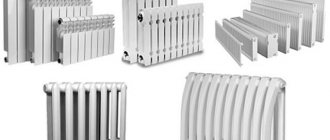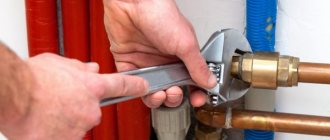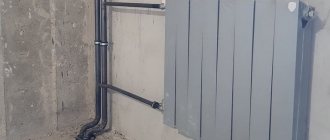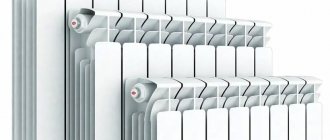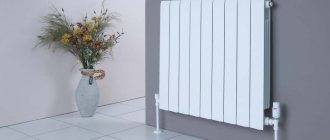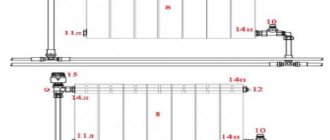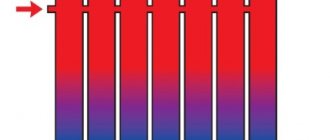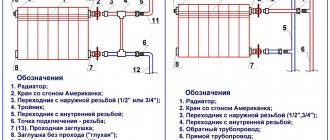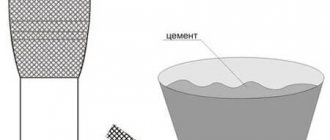Cast iron sectional radiators
The first development of cast iron batteries was carried out almost 150 years ago by our compatriot. A few years later, the Americans received the patent and finalized the design. Radiators gained popularity after the advent of the central heating system, and their mass production began during the Industrial Revolution.
The batteries that were used in the USSR and now remain in many homes are branded MC 140. The value “140” is the power supplied by one section. The operating and test pressure of the battery is 9 and 18 atmospheres, respectively. Number of sections – from 4 to 10.
Today, cast iron radiators are again gaining popularity, thanks to improvements in their design and design.
The advantages and disadvantages of batteries of this type are approximately the same.
- Long service life (more than 50 years);
- Affordable price;
- Resistance to mechanical damage;
- Corrosion resistance;
- High abrasive wear. Pebbles and sand in water do not cause much damage to the battery from the inside;
- Heating efficiency with the maximum number of sections.
- Heavy weight and bulkiness;
- Possibility of depressurization of joints;
- Accumulation of rust inside during long-term use;
- Unpresentable appearance;
- Difficulty in integrating radiators into autonomous heating systems, the impossibility of saving on coolant;
- Difficulty in cleaning.
Radiators made of Corado steel
The Czech company Corado is already well known on the domestic market. This is due to the design features of its products.
Corado steel radiators (technical characteristics in the product data sheet confirm this) are made from pressed sheet cold-rolled steel:
- The material from which Czech panels are made is chemically inert, so it is not affected by low or high pH values of water.
- A large model range allows you to choose a heater of the required power, color and size (table of steel heating radiators from this issue).
- They contain less coolant, which reduces energy consumption for heating it.
As experts note, Corado radiators offer unsurpassed quality at an affordable price.
To summarize, we can say that steel panel radiators are an opportunity to choose an effective model from a wide range of products with the required level of heat transfer, which will create pleasant warmth and microclimate in any room.
Convector radiators
Convector-type radiators are connected to a conventional heating system. A distinctive feature is a completely different way of functioning.
Panel, sectional or tubular radiators release heat into the environment from their hot surface, which allows them to heat the room.
Convectors work differently. Their design provides for the presence of many thin air channels located between the ribs of the plates.
The air in the room passes through them, at the same time it heats up, becomes lighter and rises, which ensures continuous movement and mixing of air, i.e. constant heating
This allows you to evenly warm the room, which is important, even the presence of many interior items and partitions will not interfere
- They are light, compact and reliable, because... made from copper, steel and aluminum - corrosion-resistant materials
- Requires a relatively small volume of water in the system.
- Heats up quite quickly and cools down just as quickly
- Such radiators allow you to heat rooms with high ceilings
- A heating system with convector radiators allows you to save money when purchasing equipment. Those. In such a system, pipes of small diameter are used, the power of the circulation pump is quite low, and the coolant itself has a small volume.
- Very simple installation, which can be carried out without any special skills.
- There is a huge selection of appearance options for the convector housing. What can be a beautiful addition to your interior. Replacing the housing is very simple and only takes a few minutes.
- Increased security, i.e. The heat exchanger is completely closed by the housing.
All batteries have their drawbacks, which are functional in nature. The convector radiator is durable, economical, safe and quite beautiful. The only negative is the high price, because they are made from high-quality and expensive materials.
Such a characteristic as power will help to correctly give preference to one or another type of radiator. It is easy to calculate it: in a room with a ceiling height of 300 cm and one window, 100 W will be needed to heat one square meter. When the room has two external walls, add another 20%. If there are two external walls and two windows, add 30%. When the window faces north, you should add 10%. An important factor will be the installation of radiators, because no matter how good the batteries you purchase, if they are installed incorrectly, it will still be of zero use.
There are certain rules for installing radiators:
- batteries must be placed under windows
- their length must correspond to the length of the window, or at least half the length
- in the corner room you can install an additional pair of radiators along the outer wall
- It is better to install heating risers in corners. This will ensure they warm up and avoid blackening of the wall and the formation of mold.
- they must always be available.
When choosing heating radiators, you should rely on the technical characteristics of the radiators and the heating system itself, as well as your budget. With proper study, you can always find a middle ground for yourself.
You might be interested in reading:
- Installation of sandwich chimneys through the wall of the house. Step-by-step technology
- How to heat a country frame house. Options and profitable ideas
- Do-it-yourself stove installation for a home with a water circuit for heating
- Do-it-yourself chimney cap and installation in the house
Connection options for heating elements
Connecting a plate battery.
Any factory-made plate heating element is equipped with a kit with a built-in valve insert. It, together with the thermostat, participates in the process of adjusting the temperature of the radiator. In addition, there are batteries with an integrated complex through which they are connected to the heating circuit pipes located under the floor or mounted in the wall.
Convectors in most cases can have either a side or bottom connection. In the case of the lateral connection method, the fittings of the heating element are brought out to the side of its casing. With horizontal heating wiring, the owner of the battery will have to buy a special fitting. It will help adapt a horizontally located device and a vertically rising section of reinforcement from a horizontal contour. Things are better if the heating circuit runs vertically through the room. Then the fitting is not needed.
With a bottom connection, the radiator pipes exit to the surface of the casing from below. This simplifies the connection of the heating element to a horizontal circuit, but complicates the installation process in the case of vertical wiring.
A steel plate heating radiator should only be connected to a system with forced coolant circulation. Otherwise, water will move at a low speed through the system, which will degrade the performance of the heating element.
It is not recommended to install steel plate convectors in a heating system with an open expansion tank. In this case, the coolant is regularly enriched with oxygen due to direct contact with air. As a result, the acidity of the coolant increases, which leads to corrosion of the inner surface of the radiator tubes. Their service life is reduced.
If water convectors are nevertheless installed in an open heating system, then the circuit must be equipped with an anti-diffusion barrier. It prevents oxygen from entering the heating circuit.
Steel panel radiators
These radiators are rectangular panels:
The panel radiator is made of two steel sheets welded together. Vertical grooves are pressed into the sheets through which the coolant circulates.
Steel panel radiators are made of one, two or three panels. Vertical pipes are welded to the back sides of these panels to enhance convection:
Pipes to enhance convection for panel radiators
Panel radiators are produced in heights of 300...900 mm, lengths up to 3 m, depths of 60...165 mm.
The advantage of panel radiators is their low weight, thanks to which they can be mounted alone, powerful brackets are not needed, and the wall material can be not only concrete or brick, but also wood and some kind of frame cladding (as you probably guessed, comparison carried out with cast iron radiators).
In panel radiators it is easy to control the coolant temperature due to the low thermal inertia of these heating devices.
Disadvantages of steel panel radiators:
- panel heating radiators are designed for low pressure (6-8 atm - working and up to 13 atm. test), hence their sensitivity to water hammer;
- the inner surface of the panels is susceptible to corrosion;
- poor hygiene, because dust and cobwebs accumulate between the panels, and getting to this nasty stuff is very difficult.
From all of the above, we draw conclusions: it is more correct to install panel radiators in private homes and take care of the quality of the coolant.
Types of steel heating radiators and their technical characteristics
Steel is a good material for heating radiators, because it can be processed and conducts heat well.
They can be divided into three types:
- Panel steel radiators.
- Plate radiators.
- Tubular batteries.
Structure of panel radiators
The simplest battery of this type consists of two steel plates. Each of them has a certain number of grooves made with a flat bottom. Almost all of them are vertical. A wider flat groove is made along the perimeter of each plate. When one plate is applied to another, the grooves overlap and form channels for the movement of water.
Both plates are held together by spot welding. At the corners of a single-panel radiator, fittings are welded to connect the incoming and outgoing pipes. The fittings are attached to the channel, which is located around the perimeter of the panel. Many manufacturers attach a Mayevsky valve (designed for bleeding air) to one of the fittings at the top of the panel radiator. A tap is always placed on the inlet pipe to regulate the flow of coolant. The outlet pipe is always located at the bottom.
A convector is placed on the side that will “look” at the wall. It is a steel panel with ribs that are U-shaped.
These ribs are located along the entire height of the device, that is, they occupy the entire space between the top and bottom sides. When the radiator operates, they heat up, making the air inside them warm. The air then rises and moves into the room. Air convection is created. There are models that do not have such convectors.
The number of panels ranges from 1 to 3.
Types of panel radiators
They are indicated by numbers. Their list is as follows:
- 10 – is a radiator with one panel without a convector. It also has no lining;
- 11 – this type of radiator is single-panel, but its heat transfer is improved by the presence of one convector;
- 20 – consists of two panels and an air outlet grille placed on top. There is no convector;
- 21 – is a double-row radiator with a radiator attached to one panel. There is a protective casing on the sides and top;
- 22 – is a structure of two panels and two convection convectors located between them. There is a side and bottom protective casing;
- 30 – formed from three panels. From above they are covered with a flat grille.
- 33 – three-panel device. Its design includes 3 convection fins and a casing.
Technical features
Steel heating radiators have the following technical characteristics:
- The height ranges from 30-90 cm. The length can reach 3 m. The depth ranges from 60 to 165 mm.
- The center-to-center distance is 10-70 cm. This characteristic is important for the lateral connection method. The greater the distance between the axes, the better the coolant circulation. In case of lateral connection, it is better to take models with a large center distance.
- The thickness of the steel used is 1.2-1.5 mm. It is better to use steel radiators made of thicker material.
- Connection methods: bottom and side. When making the first type of connection, you can install a thermostatic valve and fix the thermostat on it. Thanks to this, you can control the operation of the radiator. The second type of connection involves connecting the input and output pipes to one side of the battery.
- Low weight. It depends on the features of the specific model. This mass allows you to use not very strong brackets and fix them not only on brick and concrete walls, but also on wood and the cladding of a frame house.
- Heat output 1.2-1.8 kW. It could be more. It all depends on the size of the steel radiator.
- Low thermal inertia. The battery heats up quickly and instantly responds to changes in the position of the thermostatic valve.
- Working pressure – 6-8 atm. Test does not exceed 13 atm. For this reason, such steel heating radiators should not be used in apartment buildings. It is better to install them in houses with an individual heating system.
Their internal surface is not protected against corrosion. As a result, it is impossible to drain water in the summer. For them you need to select a special coolant. You can find out about it in the technical documentation.
The weak point of these batteries is also their poor hygiene. A lot of dust and cobwebs always accumulate between panels with convection fins. It is very difficult to get them out of there, especially from the lower part.
Structure of plate air heaters
Plate steel radiators consist of:
- Heat exchanger.
- A large number of plates.
- Casing.
The heat exchanger is a pipe bent into an arc.
The number of pipe bends depends on the model. Mostly batteries use one or two arcs. These arcs are heated by the coolant. Then the heat is transferred to the plates welded onto the coil. They create convection. It is weaker than convection of panel heating devices. This difference is compensated by the greater heat transfer of the main pipe.
Often the coil and plates are hidden in the housing. Such a battery looks like panel steel radiators.
There is always a protective casing around the plates. First of all, it protects the inhabitants of the house, because the pipe and the panels welded on it become very hot. The casing cannot heat up above 40 °C. Therefore, it is impossible to get burned by accidental contact.
These steel heating radiators have such technical characteristics that allow them to be part of centralized heating systems. The coil is able to cope with pressure of almost 40 atm.
This is an excellent solution for heating high rooms because the air immediately rises and is able to reach the ceiling. At the same time, it forms a thermal curtain. However, heating of the room occurs unevenly along the height.
Some models of plate radiators have built-in fans. The latter accelerate the movement of air between the plates and improve heat transfer by several tens of times. Therefore, it is better to buy such options.
In the West, radiators of this type are used more efficiently. There they install in houses:
- In-floor radiators.
- Specialized batteries of the required shape.
- Decorative panels. In this case we are talking about baseboard radiators. They have a height of more than 20 cm and an impressive length. They are disguised using decorative panels.
Some models have copper elements. Although copper has a very high thermal conductivity, it can cause electrochemical corrosion of system elements. This must be taken into account when creating heating and connecting such heat sources.
Over time, they reduce their heat output . This is due to dust that settles on the plates. Heat transfer can be restored by cleaning.
Technical characteristics of plate batteries
Most models are designed for a working pressure of 15-16 atm. The test value is 22.5-24 atm. There are models in which:
- Working pressure is 25 atm.
- Test - 37.5 atm.
Experts note that it is better to install such convectors in:
- corridors;
- swimming pools;
- rooms with high ceilings;
- on the loggias;
- near large stained glass windows.
For bedrooms and children's rooms it is better to choose other heating devices.
Tubular radiators: structure
These heating devices are very different from the two types described above. Some of their modifications are more similar to cast iron batteries. This is because they have sections through which water circulates. These sections are connected into one solid structure.
One section can have from 2 to 6 tubes. This feature of tubular steel radiators improves heat transfer and makes them more useful.
Technical features
Tubular steel radiators can be of any length.
It all depends on the specifics of the project. It can even reach 5 meters. The altitude range is also large. So, the smallest value is 19 cm, and the largest is 300 cm. There is a serious limitation on depth. It cannot exceed 22.5 cm.
Other characteristics are:
- Working pressure – 10 and 15 atm (Russian and foreign models, respectively).
- Pressure testing - 15 and 22.5 atm.
- The walls have a thickness of 1-1.5 and 2 mm.
Such heat sources are hygienic, injury-proof and beautiful.
General disadvantage of steel radiators
The “weak link” common to all steel radiators is their susceptibility to oxygen. Well, that is, they rust, as everyone well knows. Moreover, they rust not so much on the outside as on the inside, when the coolant is drained from them.
This does not mean that you should completely disown steel batteries. You just need to understand in which heating systems they should be installed. Steel batteries are suitable for closed systems. As a rule, this is in private homes.
That's all about steel radiators, I hope now you can decide exactly which heating radiator to choose.
When arranging a home with a heating system, it is necessary to pay special attention to heating devices, in particular radiators. The level of heating of the room largely depends on them
Among the variety of such elements, I would like to mention thin radiators. They are much lighter in weight than cast iron heat exchangers, which makes their installation process easier and more convenient.
Types of thin panel batteries
The peculiarity of such devices as steel panel heating radiators is that they combine the properties of a convector and a battery. They are usually produced in the form of rectangular panels of different thicknesses and dimensions. In the photo you can see what they look like.
The design of steel heating panel radiators is simple:
- the base of the device is a panel consisting of two profiled steel plates, which are connected along the perimeter with a weld. Inside, vertically located oblong channels are formed from steel using the stamping method. Hot coolant circulates through them during the heating process;
- U-shaped ribs are welded to the panels on the back side, resulting in more efficient heat transfer. This element for convective heating of a room is made from cold-rolled steel, only thinner;
- the design of one device can consist of the three panels described above. In the case of connecting several panels into a single system, manufacturers cover them using side covers;
- A steel panel heating radiator can have a variety of dimensions. Most models presented on the domestic market have heights from 300 to 900 millimeters and widths from 400 to 3000 millimeters. The depth of the panel device depends on the number of steel panels and can reach 170 millimeters.
- with side connection;
- with bottom connection;
- with universal connection.
In terms of cost, the most expensive models are those with a lower connection option, since they often have a thermostat built into them. If the device does not have a built-in thermostat, it is connected using a special thermostatic valve.
Panel steel radiators have technical characteristics depending on the model:
- operating pressure in the range of 6 – 8.5 atmospheres;
- crimping pressure does not exceed 13 atmospheres;
- The maximum temperature of the coolant is no more than 110 – 120 °C.
All manufacturers use the same classification of thin flat heating radiators.
We suggest you read: How to bleed air from a heating system pump
We are talking about five types of heating devices:
- Type 10. The simplest panel (stamped), without any decorative frills. It is classified as a popular product from the “maximum flat panel radiators for heating” series: the depth of this design is 46 mm. The most popular of this product line is the Kermi model.
- Type 11. Devices of this type are characterized by the presence of one layer of convection fins. The depth of the product was increased to 59 mm.
- Type 12. This design was somewhat complicated by dividing two flat panels with a fin system. The thickness of the device is 64 mm.
- Type 22. An even more complex scheme is used here: in addition to two panels, there are two finning systems located between the planes. The depth of such a battery is 102 mm.
- Type 33. The most complex model, which includes three planes. The first pair of panels is divided by two ribbed sections. Another section is installed between the second and third panels. Due to the increased complexity, the depth of the device also increases: it reaches 157 mm.
Heating radiator classes
There are 4 classes of heating devices:
Sectional type radiators are known to everyone. They are made of cast iron, aluminum, steel. There are models for the production of which two materials are used (usually steel and aluminum). Such batteries are called bimetallic. Sectional radiators are assembled from separate sections (sections), resulting in a heating device with the required power, which is transferred to the external environment during operation.
Sectional radiators are assembled from separate sections (sections)
Plate heaters are so called because they are made of several plates mounted on curved or straight pipes. The coolant (water) in turn circulates through the pipes. Another name for plate heating devices is convectors. Can be electric or non-electric.
Photo: tubular radiator in the interior
Tubular radiators are made of several tubes connected to each other by collectors. They look quite original. Such radiators are often found in apartments where the interior is designed by professional designers. Pipes can be made of any size and shape, for example, in the form of a certain figure.
Photo: panel radiators of different sizes
Panel heating radiators consist of panels that receive heat from a coolant circulating in the space between them through channels formed by stamping. There are models with one, two and three panels.
Let's take a closer look at each type of heating radiator.
Plate heating radiators - types and technical characteristics
Radiators are heating devices whose main task is rapid heat exchange with the internal volume of the room. This means that the batteries must not only have a large area, but also have sufficient thermal conductivity. The importance of choosing the material and type of radiator lies in the range of prices and variety of physical characteristics. In a harsh winter, not many people will want to experience first-hand the “charms” of poor-quality heating. A natural requirement for increasing heating efficiency will be good thermal insulation of the building, absence of drafts and correctly calculated operating power of the boiler equipment.
Since batteries are, albeit a key, but not the main element of the heating system, it is important to obtain a correctly designed and calculated heating project for a country house, apartment or commercial enterprise. In this case, various types and types of batteries can be used, ranging from sectional bimetallic batteries to plate convectors or even copper-aluminum panels.
Main types
Among the main (household) types of heating radiators, it is worth highlighting the most commonly used:
- Sectional (aluminum or bimetallic) - are sectionally assembled structures from segments that are connected by steel nipples. They have a pleasant appearance, can provide good convection and can consist of a different number of sections in one heating radiator.
- Tubular radiators are used less frequently; the advantages include a long period of heat transfer and a pleasant design of the device.
- Panel heaters are the most efficient heating appliances for individual construction; they have a large heat transfer area. The disadvantages include high cost, low operating pressure (up to 10 Atm). They can provide good convection; a large range of models will allow you to choose a device for any room area.
- Plate - have high operating pressure, relatively high heat transfer and provide good convection. It is possible to use heating devices according to the in-floor convector scheme, a large selection of design models and shapes.
It should be noted that in addition to the different materials used to create the device, devices also differ in coolant volume, operating pressure, and design features (for example, the number of panels, sections, heat exchangers).
Plate radiators
I would like to dwell in more detail on thermal devices of this type, such as plate radiators. They are most often used in apartment buildings and houses connected to a centralized heating main. The main problem associated with connection arises from increased pressure within the network, which can reach 13-17 Atm.
In such conditions, there are only two groups of devices capable of operating at such operating pressures - sectional and plate batteries. The remaining devices are not recommended for installation by manufacturers, since at the first significant load, structural destruction of the panels or heat exchanger will occur.
Copper-aluminum radiator design
Plate convectors are a plate-reinforced heat exchanger that can withstand loads of up to 40 atm. The convection of such radiators is much lower than that of panel radiators, but this is compensated by high heat transfer. The installed plates serve one purpose - to increase heat transfer and thermal conductivity of the radiator. Therefore, such radiators are quite common
Plate heating batteries
Along with sectional, tubular and panel heating devices, plate heating radiators have also become widespread. In terms of heat output, they are second only to panel-type heating devices. But in comparison with them they have a much lower price, can operate at a system pressure of more than 10 Atm (up to 17-20 Atm) and allow hidden installation in in-floor niches.
Outdated finned heating device.
A significant difference between plate heating batteries and other types is the method of heating the room. In all other designs, up to 70-80% of the power is spent on radiating heat and heating the walls and objects in the room, which then heats the air. In plate-type ones, this power serves to heat the air directly and enable its convection (mixing) in the middle of the room. Hence the second name for these heating systems – convector heaters.
Air heating is at the same time both a positive quality and a minus, which determine the area of use of these devices. But the thing is that heating the premises to the required temperature using heat radiation, although it takes more time, the effect of it lasts longer, and the conditions created are better suited for people to stay in from the point of view of comfort.
Behind the heat supply device there is a heat-reflecting aluminum plate.
Ribbed ones, on the contrary, can quickly heat large volumes of air to the required temperature, but at the same time they create significant air flows, which cause discomfort for people present in a stationary position. This is actually the reason for their use in the corridors of public buildings, stairwells, gyms, warehouses, etc. In other words, where there are large volumes of premises and there is constant movement of people (or does not happen, as in warehouses).
An outdated plate heating device in the entrance of a residential building
Design and types
The design of a plate heating radiator is based on one or more straight, U or W-shaped tubes, to which many metal heat exchange plates are perpendicularly welded or otherwise secured. The coolant moving through the tubes heats these plates, and they then release the resulting heat into the room.
In most cases, the finished device is placed in the middle of a thin-walled housing, which serves to protect against burns and cuts from the sharp edges of the plates. The housing or casing also protects the heater plates from dust and damage from mechanical factors. However, there are models, mainly steel radiators with increased fin thickness and trimmed edges, which are intended for operation without a casing, “as is”.
Old finned battery.
Along with the shape and size, the following main types of plate heating batteries are distinguished.
- According to the material of the device: steel; copper; bimetallic in combinations: steel - copper, steel - aluminum, less often copper - aluminum.
- By the number of pipes: single-pipe and multi-pipe with a manifold.
- By connection method to the main line: with side and bottom connections.
- According to the installation option, there are suspended heating devices and built-in type in a floor niche. The latter are placed either directly on the ceiling or on insulating material.
Outdated plate heating radiator.
If we talk about the pros and cons, then obvious positive qualities include low cost, high heat transfer and air heating speed. And also reliability due to the small number of connecting nodes. The most serious disadvantages: uneven temperature distribution across room levels and high requirements for cleanliness. Although, it would be more correct to call the latter a secret positive quality of steel plate heating radiators.
A ribbed heating device behind which is an aluminum heat-reflecting plate.
Summarizing. The vast majority of manufactured heating devices operate on the principle of convective air circulation. However, there are models with a built-in fan. This, therefore, raises the price and overall energy consumption of the device, but also by increasing the intensity of air mixing partly solves the problem of a sharp difference in temperature across the height of the room.
Design and purpose of plate radiators
You can select, buy and install any radiator, but it will be useless if the room or building is not insulated - only in combination with thermal insulation work will a plate radiator prove to be most effective. In addition, the efficiency of a radiator is not the high temperature of the coolant, which is released into the air through tubes and plates, but the maintenance of a constant and comfortable temperature in the room throughout the entire time. Therefore, if you correctly decide on the surface of such heating batteries, you cannot get burned - firstly, the temperature will not be critical, and secondly, the plates are covered with a metal casing.
If we approach the issue fundamentally, then plate heating radiators are a design variant of convectors with a difference in the number of tubes and plates (fewer tubes, more plates).
Internal structure of a plate radiator
Similar to panel-type radiators, in plate-type devices there is a classification according to the number of heat exchange tubes and panels (plates), which are manufactured by hot stamping and spot welding. Due to the tight connection, heat is transferred not only from the surface of the plates, but also from other areas of the device - from tubes and even connecting seams and joints. The marking of devices occurs in this way: if the radiator has one panel (plate on the body) and one heat exchanger, then it is marked as class “11”. Three plates and two tubes - “32” class, etc.
If you want to buy and install a new radiator in a store or replace an old one, then complete with the new model you will receive an installation kit and instructions for assembly and fastening. Depending on the design of the device, its connection can be threaded or welded, which depends on the coolant input/output device. In addition, you will need to connect the Mayevsky tap and thermostat or two separate devices - the Mayevsky tap itself and a separate thermostat. It is not at all necessary to install a thermostatic valve, but it will allow you to automatically regulate the temperature in a separate room by limiting the flow of coolant into the radiator coil. The latest models of plate batteries are often equipped with built-in thermostats and taps.
Plate heating radiators with thermostat
Aluminum radiator
Widely used to design a heating system in a private home.
They became popular due to their design and high thermal power. The cost of such radiators depends on the manufacturer. Radiators from domestic manufacturers will cost less, but after reading consumer reviews, you should give preference to foreign analogues, but their price is much higher.
When choosing an aluminum radiator for a localized system in your own home, you must adhere to a list of very significant conditions for selection and operation:
- Aluminum radiator is the most sensitive to the circulated liquid. It is necessary to strictly observe the required level of water acidity, otherwise such radiators will become unusable within several years;
- Aluminum radiators have a threaded connection. which increases the risk of leakage;
- The high thermal output of aluminum radiators has a downside. When radiators heat up, the warm air flow rises very quickly, which leads to a temperature difference between the floor and ceiling.
Aluminum radiator in section
This means that when choosing aluminum radiators, there is a need to make accurate calculations based on the area of the room, since the floor may remain cold.
But aluminum radiators also have undoubted advantages:
- Relatively light weight, which makes it possible to mount it on plasterboard walls;
- Quite aesthetically pleasing
- The presence of special taps that allow you to regulate the temperature.
Relatively low price, good design and instant heat transfer - this is the secret of the popularity of aluminum radiators.
These are quite acceptable radiators for a heating system in a private home. By strictly observing the standards of selection and use, such radiators will heat your cozy home for a long time.
All about bimetallic radiators
Bimetallic radiators have an aluminum body and a steel pipe through which the coolant moves. Roughly speaking, a bimetallic radiator is a steel frame filled with aluminum; the coolant in such radiators has almost no contact with aluminum, because moves through steel tubes, which in turn transfer heat to aluminum panels.
This type of radiator combines the best properties of aluminum radiators with the beneficial qualities of steel. Due to the strength of steel, bimetallic radiators can withstand greater pressure (for many of them the operating pressure is 20-30 atm or more) and make it possible to reduce the requirements for the quality (pH) of the coolant, which are very significant when using conventional aluminum ones. In addition, bimetallic radiators have good heat transfer and a modern design; in appearance, such radiators are very similar to aluminum ones, but are somewhat more expensive.
Bimetallic radiators are suitable for use in urban central heating systems. But as with all radiators in which the coolant comes into contact with steel, the “bimetal” is harmful due to the increased oxygen content in the coolant, which contributes to the development of steel corrosion. Therefore, it is necessary to install an automatic or manual (Maevsky tap) air vent on the radiator.
To connect bimetallic radiators to the heating system, you need an installation kit, which includes: from 2 to 4 brackets, a Mayevsky tap, two pass-through plugs of different diameters (1/2 inch or ¾ inch) and direction (left or right) and one blind plug (plug).
At the customer’s request, ball valves, valves (for dismantling the radiator or for emergency disconnection from the heating system), as well as thermostatic valves with thermal heads (to maintain the room temperature you set) can be installed on the coolant supply and/or discharge pipes.
Which heating battery to choose for your home
Shopping list? Don't like the look of the batteries in your home? Do you think that their sharp corners and elevated surface temperatures are dangerous for your little child? Buy a screen for the radiator and install it - it will not take much time and will not require serious financial investments. Meanwhile, such a product can provide:.
Plate heating radiators: characteristics, photos. Heating radiators Plate heating radiator: features of old ones.
With the onset of the warm season, it's time to think about the efficiency of your heating system. If it requires replacement, summer is the best time for installation work. At the height of the heating season, it will not be possible to replace radiators.
Thin metal plates are mounted on the tubes. They are designed to increase the level of heat exchange between the heating element and the air in the room. Plate batteries are used in public spaces and industrial buildings, industrial workshops. In frequency housing construction, they have not received proper distribution for a number of reasons. However, they are widely used for heating multi-apartment buildings, where centralized heat supply dominates. With good insulation of the building, a plate heating device is able to maintain the air temperature at the proper level with minimal thermal energy consumption.
Important: there is an opinion that the cast iron radiator now is worse than in Soviet times.
Radiators are an integral attribute of heating systems, unless heated floors are used instead. It is not always easy to combine their appearance with the interior. This can be done easier if you use radiator screens. The screens have an attractive design and shape, so there is always something to choose from. What materials are screens made of and which one is better to choose? This will be discussed in the article. The screen for a heating radiator has several purposes.
Modern heating radiators come in several types. Depending on the material from which they are made, these devices have different characteristics. This is why problems often arise with how to choose the right heating battery.
To decide which heating battery to choose, you need to pay attention not only to the size and appearance of the radiators, but also to their features
VIDEO ON THE TOPIC: Choosing a heating radiator // FORUMHOUSE
Connecting radiators
- As is already known, before sale, a plate radiator is equipped with a tap and a valve insert with a thermostat for automatically adjusting the temperature of the coolant and air in the room;
- Some models are equipped with mechanisms for connecting the radiator to the heating circuit under the floor or built into the walls of the room;
- The main radiator connection diagrams are side or bottom: With side connection, the connections of the radiator fitting are on the sides, which does not interfere with connecting them to a vertical riser. With a horizontal connection, the radiator is connected through a fitting.
- With a bottom connection, the radiator fittings are brought out from below, so a horizontal connection does not pose a problem, but for a vertical circuit, the radiator is connected through fittings.
Bottom radiator connection
Lateral radiator connection
Practical and organizational implications
The principle of operation of plate devices is the same as that of water ones - they increase and maintain the temperature in the room due to the flow of warm air.
- The reliability and strength of steel radiators is much higher than that of devices made of other alloys and metals, therefore they are recommended for use in a central heating system.
- Copper radiators are not destroyed by corrosion, but it is better not to install them in high-pressure systems. Another drawback is the high price.
- Aluminum radiators are the cheapest of all, have excellent heat dissipation, but have a mechanically weak body, which also quickly corrodes in an acidic environment.
Since the connection of plate heating devices is carried out through the lower or side fittings, they can be mounted directly on the floor, built into the floor surface or hung on the wall of the room. For each individual case, you can choose your own design and technical equipment of the device.
Plate heating devices
Introduction
A plate heating device is a bent or straight pipe for water supply, with steel plates strung on it. The coolant moves through the pipe, and the plates significantly increase air convection. Structural simplicity determines their low cost. For aesthetics, the convector heater is covered with beautiful boxes made of thin steel, painted white.
Steel plate heating devices - general information
In simple speech, steel plate heating devices are called “accordions”. The appearance of an accordion is made by plates strung on a pipe for the heat carrier.
A characteristic feature of radiators of this type is great reliability. There are no connections in a plate radiator other than the coolant inlet and outlet. As a consequence, the heating device itself simply cannot leak; there is nowhere for the coolant to push through.
Thanks to the huge number of plates and the direct movement of the coolant, the design of the radiator heats up to a high temperature. To protect from touches, the key frame of the heating device is covered with a decorative casing. Convection holes are created in the top cover of the casing.
Convector heaters have low thermal inertia, which means they can be controlled automatically; in other words, thermostats can be installed in systems with plate heating devices.
Plate heating devices form a fairly powerful curtain of heat. This property of convector heaters makes it possible to use them in floor heating systems. True, the design of thermal convector heaters for installation in the floor differs from wall-mounted convector heaters, but the heating principle is the same.
Disadvantages of plate heating devices (convector heaters)
- The convective type of heating devices does not make it possible to warm the room equally. The radiators are warmer than the opposite wall of the room.
- The convector heater plates are an excellent dust collector. They are difficult to clean. Over a period of time, dust reduces their heat output.
- The appearance of plate heating devices is not pleasing, although there are nice models.
Variations of plate heating devices
As options, plate heating devices are used for heating in the floor (duct convectors) and baseboard heating of the room.
Connecting convector heaters
Two types of convector heaters are sold by connection. This is something you need to look at when purchasing. The first type is a convector heater with a side connection. The second type is a convector heater with a bottom connection0. It is equipped with a valve insert.
Heating capacity of plate heating devices
The heat output of convector heaters depends on their length and the number of rows with plates. The height of all convector heaters is 200 mm.
Thus, the heat transfer of a convector heater into “one thread” 600 mm long is 347 W. It is 3000 m long and produces a heat output of 1730 W. A heating device in 4 “threads” with a length of 3000 mm gives a heat output of 4179 W, and one with a length of 1000 mm will give out 1393 W of heat.
The calculation of the heating device is carried out according to the standard scheme for calculating sections of heating devices, taking into account all correction factors. Let me remind you how this is done. (read publication: The simplest calculation of a heating system)
- For 1 sq. meter of area with a ceiling of 3 meters, 100 W of heat is required.
- For a room of 16 sq. meters, a 1600 W heating device is required. This is under good conditions: one window, 3-meter ceiling, the room is not corner. If this is completely wrong, we use correction factors:
- Two windows k=1.8: 1600?1.8=2880W;
- Corner room k=1.8: 2880?1.8=5184W;
- Ceiling 2.65, k=2.65/3.0=0.88: 5148W?0.88=4547 W;
- PVC window k=0.8: 4547W?3637W.
A standard window has a width of 1400 mm, which means that under each window it is necessary to install 4-section plate heating devices 1400 mm long, with a heat output of 1950 W. The data is taken from the passports of Purmo heating devices. That's all!
Specifically for Obotoplenii.ru
Is it worth buying plate heating devices?
Old style plate radiator.
Any buyer asks a similar question when he is asked to pay attention to a heating device that is so unpopular in our time - a plate radiator.
The following number of advantages speaks in its favor:
- simplicity of design;
- low purchase cost and inexpensive service;
- durability when used correctly;
- high speed of heating the room.
As practice shows, if the structural material is steel, then the equipment is able to withstand pressure up to 20 atm, which has a positive effect on its performance and durability. In addition, the plate radiator will not be harmed by high coolant temperatures (120°C and above).
If old-style plate heating radiators had an unsightly appearance, modern equipment models have an interesting design. This will help when creating the interior of the room. Such radiators no longer have to be hidden behind panels, which, by the way, reduces their performance. They act as a kind of decoration for the room.
Disadvantages of the device:
- heating the room only due to convection. However, the efficiency of the device can be increased by equipping it with a fan;
- as the coolant temperature decreases, the efficiency of the equipment decreases. The air temperature in the room also drops sharply;
- Dust accumulates between the plates.
Options for how you can set up gas heating for your garage with your own hands.
As an example, here is a diagram of steam heating without a pump. This is also possible.
Choosing which heating radiators for a private home is best
When the construction work in the house is completed, the question arises of how to arrange the heating system so that the house is warm.
The main component of the heating system is, of course, the heating radiators. Their choice must be approached with particular seriousness, because the strength, durability and reliability of your heating system depend on it. Let's consider the main advantages of the heating system of a private house:
- Its operation is carried out at low pressure, which has a beneficial effect on operation;
- There are no large water shocks in this system, which provides a wide selection of radiators;
- By observing the necessary technical conditions for the acid balance of water, the choice of radiators is very wide.
Taking into account the above, the choice of radiators should be made taking into account the maximum heat transfer coefficient and a good price-quality ratio. Without going into details, any type of radiator can be used in a private home. But knowing the advantages of one or another still won’t hurt.
The following types of materials are used for the manufacture of radiators: cast iron, aluminum, metal (steel), bimetal.
Determination of thermal power of plate heating devices
The formula for determining the thermal power that a steel plate heating radiator can produce, and a real example of calculating this parameter, are given below. To calculate the power of the device, it is enough to know the heat loss coefficient of the heated room, the area of the room and its total volume. The passport of any radiator indicates its calculated power at a hot water temperature in the system of 60 0 C. Also, the attached documentation indicates recommendations for the heated area for a specific radiator model.
The thermal output (power) of heating devices depends on the length of the body and the number of plates. The standard height of radiators is 200 mm, the number of plates varies. For example, heat transfer for a radiator with one tube and a body length of 600 mm will be equal to ≈ 347 W. When the length is increased to 3000 mm, the heat transfer will increase to 1730 W. But with the same body length (3000 mm) and an increase in pipes to 4, heat transfer there will already be 4179 W, and with a body length of 1000 mm, four tubes with coolant will give 1393 W of power. Therefore, which radiator is best to buy for a specific room is determined based on the following requirements:
- To heat 1 m2 of a room with a ceiling height of 3 m, you need to spend 100 W;
- For a room with an area of 16 m2, the radiator must have a thermal power of 1600 W, provided that the room has no more than one window, the room is not corner and the ceiling has a height of no more than 3 m. For other initial conditions, correction factors Kp are introduced:
- For two windows Kp = 1.8 / 1600 x 1.8 = 2880 W;
- For a corner room Kp = 1.8 / 2880 x 1.8 = 5184 W;
- For a ceiling 2.65 meters high Kp = 2.65 / 3.0 = 0.88 / 5148 W x 0.88 = 4547 W;
- For PVC windows Kp = 0.8 / 4547 W x 3637 W.
Panel radiators
To make a panel radiator, you need to take two steel sheets, fin them and weld them together. Connect the structure to the pipes of the heating system, let in the coolant and enjoy life.
There can be from one to three panels. All of them are available in different sizes. The design is lightweight. Such radiators can be controlled automatically.
Photo: panel radiators
- Painful sensitivity to pressure surges;
- Difficulty of care;
- Sensitivity to the composition of the coolant;
- Work at low pressure (7-9 atmospheres, short-term – 12-14 atmospheres);
- Rusting.
Experts advise installing batteries in private homes with high-quality coolant.
Radiator design
Depending on the design features, radiators can be divided into several subtypes:
- Sectional heating radiators - these batteries have several sections, so you can assemble a radiator of the desired size and power. The sizes and shapes of sections may vary.
- Tubular radiators are a solid metal structure that has an upper and lower horizontal collector and vertical tubes welded to it. Such batteries are the prerogative of centralized heating, for which they were designed.
- Panel batteries can be either steel or concrete. Concrete ones are built inside walls; they can only transfer heat by radiation.
- Plate batteries - have convective heat exchange, consist of a core and ribs made of thin metal plates mounted on it.
Separately, there are corner heating radiators. They can be made in any given design option. However, corner radiators are designed for installation in the corners of rooms.
Corner radiators
What types of low heat exchangers are there?
Devices are distinguished based on the following criteria: the type of material from which they are made, the design features of the main components - sections, plates and height. They are produced in heights from 200 to 450 mm, lengths from 500 to 6,000 and depths from 10 to 230. The following types are distinguished:
1. Cast iron sectional, ribbed. The advantages are good thermal inertia and corrosion resistance. Disadvantages: low operating pressure up to 10 atmospheres, fragility, susceptibility to the accumulation of dirt and plaque inside the channels, which reduces heat transfer over time. Compact batteries made of cast iron are models MC 140M-300 (height 388 mm).
2. Steel panel radiators consist of one or more heating plates enclosed in a ribbed shell. They have excellent thermal conductivity and low inertia, and consume a minimal amount of coolant. For example, a steel radiator measuring 100 mm deep, 300 mm high and 1,000 long can create an effective thermal curtain near a window with a glazing area of up to 4 m2.
Disadvantages: not resistant to water hammer; when water is drained, corrosion can form on the walls of the panels; the convection method of heat transfer contributes to the formation of small dust particles in the room. Of all compact heating devices they have the highest cost. For example, the price of a Kermi radiator with a height of 300 mm, depending on the length and depth, is 1,260 - 5,100 rubles.
3. Aluminum casting and extrusion sections are characterized by light weight, good heat dissipation and elegant design. The technical characteristics of a low aluminum radiator allow it to withstand operating pressures of up to 16 atmospheres. Disadvantages: low convection, service life (10-15 years), instability to water hammer and, as a result, possible leaks between sections. You can buy a 200 mm battery made of aluminum for 340 - 1,250 rubles.
4. Bimetallic ones consist of 2 parts: a core made of steel or copper pipes and an aluminum shell. The advantages are: the ability to withstand high (up to 100 atmospheres) pressure, small volume of water consumed and good corrosion resistance. The sectional low bimetallic radiator Rifar Base 200 has a closed rear surface, which allows it to be mounted in close proximity to glass surfaces. Some models are equipped with legs for installation on the floor. However, in terms of heat transfer, bimetallic batteries are inferior to aluminum products, and their cost is 10-15% higher.
5. The lowest are plate batteries of the convector type. Such linear or plinth radiators have a height of 200 to 400 mm and can be attached to the wall and floor, and, if necessary, covered with decorative grilles. They are characterized by good heat transfer and the ability to withstand operating pressures of up to 20 atmospheres. Produced in the form of solid products of a certain length. If there is a leak, they require a complete replacement, which causes some inconvenience.
What to consider when purchasing
The modern market for heating appliances is saturated with products from Russian and global brands that differ in technical characteristics, quality, and price. In order to avoid unnecessary costs and not make mistakes with quality, experts recommend taking into account the following factors:
1. For centralized heating systems that are installed in residential multi-storey buildings, cast iron radiators are suitable. For buildings with panoramic windows, it is better to use bimetallic or aluminum ones.
A clever meter that saves electricity. Pays for itself in 2 months! Everyone needs to know this in order to save!
For closed heating systems that are installed in private homes, batteries made of steel or aluminum are recommended.
2. The length of the radiator must correspond to the size of the window opening or be 10-20 cm longer. Otherwise, it will not be possible to create an effective thermal curtain, which will lead to uneven heating of the air in the room.
Technical characteristics and cost of the most popular models
Aluminum
Aluminum heating radiators are made not from pure aluminum, but from an alloy based on it. This metal was not chosen by chance, as it has one of the highest heat transfer coefficients - 4-4.5 times better than cast iron and 5 times better than steel.
Table with thermal conductivity coefficients of different metals
That is why aluminum radiators are distinguished by their high power (180-190 W per section), no less high heating rate and low inertia. They work very effectively in tandem with thermostats, allowing you to maintain a stable temperature with an accuracy of one degree. The advantages of aluminum radiators include their low weight (one section weighs 1.5-2 kilograms), which makes delivery and installation easier. Another positive point is that the shape is designed so that it has a large cross-section of channels for the coolant (slightly smaller than that of cast iron “accordions”). This is good, since there is a low probability that these channels will become clogged and the radiator will stop heating.
Now about the disadvantages of aluminum radiators. They are related to the properties of aluminum. As you know, it is a chemically active metal. It actively interacts with most of the chemical table, and reacts especially violently with copper. And in modern heating systems, copper parts are often found. Such a proximity threatens the rapid release of copper parts of the system and system, as well as increased gas formation. They have learned to deal with gases - they install automatic gas vents (valves) in systems, and they save copper by not placing it close to aluminum appliances. The process, of course, is still going on, but not with such intensity.
Aluminum radiators look modern
The chemical activity of aluminum also manifests itself in demands on the quality of the coolant. Not in the sense of its contamination, but in the sense of its acidity. Aluminum radiators work normally in systems with coolant acidity no higher than 7 (Ph 7).
The softness of aluminum is also not very good for the operation of the heating system. The alloy from which heating radiators are made contains additives that increase its hardness, but still, they do not work in high-pressure networks. Typical operating pressure is 8-16 atm depending on the type and manufacturer.
Based on all of the above, there appears to be an area in which aluminum radiators will be the best. These are individual heating systems with boilers controlled by automation. They also do well in apartments, but only in small buildings (up to 10 floors), in which coolant with Ph 7-8 circulates.

